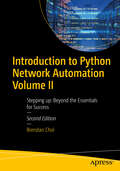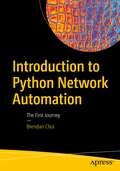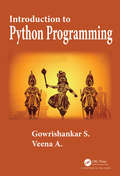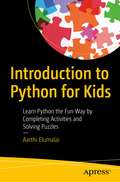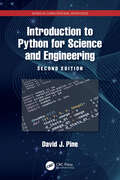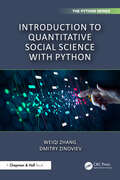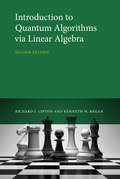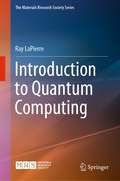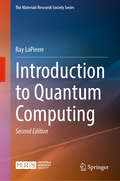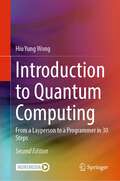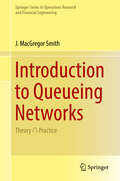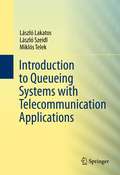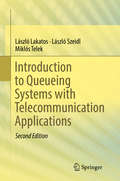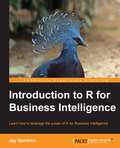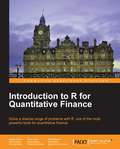- Table View
- List View
Introduction to Python Network Automation Volume II: Stepping up: Beyond the Essentials for Success
by Brendan ChoiContinue your Python network automation journey and delve deeper into advanced techniques and methodologies. Volume 2 of this comprehensive guide takes you beyond the essentials, equipping you with advanced skills and strategies crucial for success in network automation. Building upon the knowledge gained in Volume 1, you’ll set the stage for mastery in this dynamic field. You’ll start by establishing a robust lab environment for advanced automation projects tailored to your needs and use practical exercises to gain valuable insights into essential networking protocols. Then automate repetitive tasks with precision and efficiency by leveraging powerful Python libraries and tools. You’ll also see how to streamline IP address management and data center infrastructure management tasks with Python. Discover advanced techniques for network management and monitoring to optimize network performance and security. Explore the development of custom tools and applications for Cisco IOS upgrade tasks in complex network environments and put your skills to the test with real-world scenarios. All this is designed to solidify your expertise and confidence in network automation practices. Your network management capabilities will be enhanced with advanced tools, such as NetBox. Introduction to Python Network Automation Volume 2 - Stepping up provides a comprehensive roadmap to elevate your skills and excel in the dynamic field of network automation. Whether you're a seasoned professional or a newcomer to the field, this guide equips you with the tools and knowledge needed to thrive in today's network automation landscape. What You Will Learn Apply Python fundamentals and network automation strategies effectively. Utilize Python for streamlined network administration, boosting productivity. Consolidate Linux fundamentals and IP network services for enhanced network management. Practice implementing regular expressions in Python for network application development. Develop working Cisco IOS upgrading Python application in PoC environment. Explore Python's extensive applications in enterprise network automation for versatile solutions. Who This Book Is For IT engineers and developers, network managers and students, who would like to learn network automation using Python.
Introduction to Python Network Automation: The First Journey
by Brendan ChoiLearn and implement network automation within the Enterprise network using Python 3. This introductory book will be your guide to building an integrated virtual networking lab to begin your Network Automation journey and master the basics of Python Network Automation. The book features a review of the practical Python network automation scripting skills and tips learned from the production network, so you can safely test and practice in a lab environment first, various Python modules such as paramiko and netmiko, pandas, re, and much more. You'll also develop essential skills such as Python scripting, regular expressions, Linux and Windows administration, VMware virtualization, and Cisco networking from the comfort of your laptop/PC with no actual networking hardware. Finally, you will learn to write a fully automated and working Cisco IOS XE upgrade application using Python.Introduction to Python Network Automation uses a canonical order, where you begin at the bottom and by the time you have completed this book, you will at least reach the intermediate level of Python coding for enterprise networking automation using native Python tools. What You'll Learn Build a proper GNS3-based networking lab for Python network automation needsWrite the basics of Python code in both the Windows and Linux environmentsControl network devices using telnet, SSH, and SNMP protocols using Python codesUnderstand virtualization and how to use VMware workstationExamine virtualization and how to use VMware Workstation ProDevelop a working Cisco IOS upgrade application Who This Book Is For IT engineers and developers, network managers and students, who would like to learn network automation using Python.
Introduction to Python Programming
by Gowrishankar S Veena AIntroduction to Python Programming is written for students who are beginners in the field of computer programming. This book presents an intuitive approach to the concepts of Python Programming for students. This book differs from traditional texts not only in its philosophy but also in its overall focus, level of activities, development of topics, and attention to programming details. The contents of the book are chosen with utmost care after analyzing the syllabus for Python course prescribed by various top universities in USA, Europe, and Asia. Since the prerequisite know-how varies significantly from student to student, the book’s overall overture addresses the challenges of teaching and learning of students which is fine-tuned by the authors’ experience with large sections of students. This book uses natural language expressions instead of the traditional shortened words of the programming world. This book has been written with the goal to provide students with a textbook that can be easily understood and to make a connection between what students are learning and how they may apply that knowledge. <P><P> Features of this book <P><P> This book does not assume any previous programming experience, although of course, any exposure to other programming languages is useful <P><P> This book introduces all of the key concepts of Python programming language with helpful illustrations <P><P> Programming examples are presented in a clear and consistent manner <P><P> Each line of code is numbered and explained in detail <P><P> Use of f-strings throughout the book <P><P> Hundreds of real-world examples are included and they come from fields such as entertainment, sports, music and environmental studies <P><P> Students can periodically check their progress with in-chapter quizzes that appear in all chapters
Introduction to Python Programming for Business and Social Science Applications
by Paul Kaefer Frederick KaeferWould you like to gather big datasets, analyze them, and visualize the results, all in one program? If this describes you, then Introduction to Python Programming for Business and Social Science Applications is the book for you. Authors Frederick Kaefer and Paul Kaefer walk you through each step of the Python package installation and analysis process, with frequent exercises throughout so you can immediately try out the functions you’ve learned. Written in straightforward language for those with no programming background, this book will teach you how to use Python for your research and data analysis. Instead of teaching you the principles and practices of programming as a whole, this application-oriented text focuses on only what you need to know to research and answer social science questions. The text features two types of examples, one set from the General Social Survey and one set from a large taxi trip dataset from a major metropolitan area, to help readers understand the possibilities of working with Python. Chapters on installing and working within a programming environment, basic skills, and necessary commands will get you up and running quickly, while chapters on programming logic, data input and output, and data frames help you establish the basic framework for conducting analyses. Further chapters on web scraping, statistical analysis, machine learning, and data visualization help you apply your skills to your research. More advanced information on developing graphical user interfaces (GUIs) help you create functional data products using Python to inform general users of data who don’t work within Python. First there was IBM® SPSS®, then there was R, and now there′s Python. Statistical software is getting more aggressive - let authors Frederick Kaefer and Paul Kaefer help you tame it with Introduction to Python Programming for Business and Social Science Applications.
Introduction to Python Programming for Business and Social Science Applications
by Paul Kaefer Frederick KaeferWould you like to gather big datasets, analyze them, and visualize the results, all in one program? If this describes you, then Introduction to Python Programming for Business and Social Science Applications is the book for you. Authors Frederick Kaefer and Paul Kaefer walk you through each step of the Python package installation and analysis process, with frequent exercises throughout so you can immediately try out the functions you’ve learned. Written in straightforward language for those with no programming background, this book will teach you how to use Python for your research and data analysis. Instead of teaching you the principles and practices of programming as a whole, this application-oriented text focuses on only what you need to know to research and answer social science questions. The text features two types of examples, one set from the General Social Survey and one set from a large taxi trip dataset from a major metropolitan area, to help readers understand the possibilities of working with Python. Chapters on installing and working within a programming environment, basic skills, and necessary commands will get you up and running quickly, while chapters on programming logic, data input and output, and data frames help you establish the basic framework for conducting analyses. Further chapters on web scraping, statistical analysis, machine learning, and data visualization help you apply your skills to your research. More advanced information on developing graphical user interfaces (GUIs) help you create functional data products using Python to inform general users of data who don’t work within Python. First there was IBM® SPSS®, then there was R, and now there′s Python. Statistical software is getting more aggressive - let authors Frederick Kaefer and Paul Kaefer help you tame it with Introduction to Python Programming for Business and Social Science Applications.
Introduction to Python and Large Language Models: A Guide to Language Models
by Dilyan GrigorovGain a solid foundation for Natural Language Processing (NLP) and Large Language Models (LLMs), emphasizing their significance in today’s computational world. This book is an introductory guide to NLP and LLMs with Python programming. The book starts with the basics of NLP and LLMs. It covers essential NLP concepts, such as text preprocessing, feature engineering, and sentiment analysis using Python. The book offers insights into Python programming, covering syntax, data types, conditionals, loops, functions, and object-oriented programming. Next, it delves deeper into LLMs, unraveling their complex components. You’ll learn about LLM elements, including embedding layers, feedforward layers, recurrent layers, and attention mechanisms. You’ll also explore important topics like tokens, token distributions, zero-shot learning, LLM hallucinations, and insights into popular LLM architectures such as GPT-4, BERT, T5, PALM, and others. Additionally, it covers Python libraries like Hugging Face, OpenAI API, and Cohere. The final chapter bridges theory with practical application, offering step-by-step examples of coded applications for tasks like text generation, summarization, language translation, question-answering systems, and chatbots. In the end, this book will equip you with the knowledge and tools to navigate the dynamic landscape of NLP and LLMs. What You’ll Learn Understand the basics of Python and the features of Python 3.11 Explore the essentials of NLP and how do they lay the foundations for LLMs. Review LLM components. Develop basic apps using LLMs and Python. Who This Book Is For Data analysts, AI and Machine Learning Experts, Python developers, and Software Development Professionals interested in learning the foundations of NLP, LLMs, and the processes of building modern LLM applications for various tasks.
Introduction to Python for Humanists (Chapman & Hall/CRC The Python Series)
by William MattinglyThis book will introduce digital humanists at all levels of education to Python. It provides background and guidance on learning the Python computer programming language, and as it presumes no knowledge on the part of the reader about computers or coding concepts allows the reader to gradually learn the more complex tasks that are currently popular in the field of digital humanities. This book will be aimed at undergraduates, graduates, and faculty who are interested in learning how to use Python as a tool within their workflow. An Introduction to Python for Digital Humanists will act as a primer for students who wish to use Python, allowing them to engage with more advanced textbooks. This book fills a real need, as it is first Python introduction to be aimed squarely at humanities students, as other books currently available do not approach Python from a humanities perspective. It will be designed so that those experienced in Python can teach from it, in addition to allowing those who are interested in being self-taught can use it for that purpose.Key Features: Data analysis Data science Computational humanities Digital humanities Python Natural language processing Social network analysis App development
Introduction to Python for Kids: Learn Python the Fun Way by Completing Activities and Solving Puzzles
by Aarthi ElumalaiWant to create cool games and apps to impress your friends (or yourself), but not sure where to start? Or, have you tried your hand at programming, but got utterly bored after combing through hundreds of pages of dry text? Then you’ve come to the right place! This book is the perfect blend of education and fun for kids 8 years and above looking to learn the magic of Python, one of the easiest and most powerful programming languages around, all while solving fun puzzles and building your own projects on the way. Yes, there’ll be chapters on the fundamentals of Python, such as variables, numbers, strings, automation with conditions, loops and functions, objects, and files. But, early on in the book you’ll get started with Turtle, a Python package that was custom-made for kids like you. It lets you literally draw and animate on your computer! Every concept will be interspersed with a fun mini project with Turtle, so you’ll never get bored. Once you get the fundamentals down, you’ll dive right into Tkinter and Pygame, more fun Python packages (goodbye theory!) and you’ll learn all about creating apps and games like the ones you see and use every day (bouncing ball, temperature converter, calculator, rock-paper-scissors, and so much more!). There are also four capstone projects at the end of the book that convert everything you’ve learned so far into full-blown apps and games that you can show off to your friends, parents, and even teachers! You’ll be creating a snake game with Turtle, a tic tac toe game with Tkinter, a full-fledged paint app, again with Tkinter, and finally, a classic space shooters game with Pygame (the cherry on top). Every project chapter will be accompanied with the logic behind the game/app and an explanation on how you’ve arrived at the logic. You’ll develop strong problem solving skills that’ll help you create future projects on your own. There are also two chapters dedicated to just creating fun mini projects and puzzles, one of them placed in the middle of the book to give you a welcome break from all the learning. The book ends with an overview on web development with Python and ideas for more fun projects and puzzles you can solve on your own. Become the “most likely to succeed” kid in your grade while having the most fun getting there! What You'll Learn Gain a gentle, but thorough introduction into the world of programming and Python Create programs and solve problems with core Python concepts Build mini projects and capstone projects (showcase worthy) with Turtle, Tkinter, and Pygame Develop programming skills while doing the puzzles and activities described in the book Who This Book Is ForKids 8 years and above.
Introduction to Python for Science and Engineering (ISSN)
by David J. PineIntroduction to Python for Science and Engineering offers a quick and incisive introduction to the Python programming language for use in any science or engineering discipline. The approach is pedagogical and “bottom up,” which means starting with examples and extracting more general principles from that experience. No prior programming experience is assumed.Readers will learn the basics of Python syntax, data structures, input and output, conditionals and loops, user-defined functions, plotting, animation, and visualization. They will also learn how to use Python for numerical analysis, including curve fitting, random numbers, linear algebra, solutions to nonlinear equations, numerical integration, solutions to differential equations, and fast Fourier transforms.Readers learn how to interact and program with Python using JupyterLab and Spyder, two simple and widely used integrated development environments.All the major Python libraries for science and engineering are covered, including NumPy, SciPy, Matplotlib, and Pandas. Other packages are also introduced, including Numba, which can render Python numerical calculations as fast as compiled computer languages such as C but without their complex overhead.
Introduction to Python for Science and Engineering (Series in Computational Physics)
by David PineThis guide offers a quick and incisive introduction to Python programming for anyone. The author has carefully developed a concise approach to using Python in any discipline of science and engineering, with plenty of examples, practical hints, and insider tips. <p><p>Readers will see why Python is such a widely appealing program, and learn the basics of syntax, data structures, input and output, plotting, conditionals and loops, user-defined functions, curve fitting, numerical routines, animation, and visualization. The author teaches by example and assumes no programming background for the reader. <p><p>David J. Pine is the Silver Professor and Professor of Physics at New York University, and Chair of the Department of Chemical and Biomolecular Engineering at the NYU Tandon School of Engineering. He is an elected fellow of the American Physical Society and American Association for the Advancement of Science (AAAS), and is a Guggenheim Fellow.
Introduction to Python in Earth Science Data Analysis: From Descriptive Statistics to Machine Learning (Springer Textbooks in Earth Sciences, Geography and Environment)
by Maurizio PetrelliThis textbook introduces the use of Python programming for exploring and modelling data in the field of Earth Sciences. It drives the reader from his very first steps with Python, like setting up the environment and starting writing the first lines of codes, to proficient use in visualizing, analyzing, and modelling data in the field of Earth Science. Each chapter contains explicative examples of code, and each script is commented in detail. The book is minded for very beginners in Python programming, and it can be used in teaching courses at master or PhD levels. Also, Early careers and experienced researchers who would like to start learning Python programming for the solution of geological problems will benefit the reading of the book.
Introduction to Python: With Applications in Optimization, Image and Video Processing, and Machine Learning (Chapman & Hall/CRC The Python Series)
by David Báez-López David Alfredo Báez VillegasIntroduction to Python: with Applications in Optimization, Image and Video Processing, and Machine Learning is intended primarily for advanced undergraduate and graduate students in quantitative sciences such as mathematics, computer science, and engineering. In addition to this, the book is written in such a way that it can also serve as a self-contained handbook for professionals working in quantitative fields including finance, IT, and many other industries where programming is a useful or essential tool.The book is written to be accessible and useful to those with no prior experience of Python, but those who are somewhat more adept will also benefit from the more advanced material that comes later in the book.Features Covers introductory and advanced material. Advanced material includes lists, dictionaries, tuples, arrays, plotting using Matplotlib, object-oriented programming Suitable as a textbook for advanced undergraduates or postgraduates, or as a reference for researchers and professionals Solutions manual, code, and additional examples are available for download
Introduction to Quantitative Social Science with Python (Chapman & Hall/CRC The Python Series)
by Weiqi Zhang Dmitry ZinovievDeparting from traditional methodologies of teaching data analysis, this book presents a dual-track learning experience, with both Executive and Technical Tracks, designed to accommodate readers with various learning goals or skill levels. Through integrated content, readers can explore fundamental concepts in data analysis while gaining hands-on experience with Python programming, ensuring a holistic understanding of theory and practical application in Python.Emphasizing the practical relevance of data analysis in today's world, the book equips readers with essential skills for success in the field. By advocating for the use of Python, an open-source and versatile programming language, we break down financial barriers and empower a diverse range of learners to access the tools they need to excel.Whether you're a novice seeking to grasp the foundational concepts of data analysis or a seasoned professional looking to enhance your programming skills, this book offers a comprehensive and accessible guide to mastering the art and science of data analysis in social science research.Key Features: Dual-track learning: Offers both Executive and Technical Tracks, catering to readers with varying levels of conceptual and technical proficiency in data analysis. Includes comprehensive quantitative methodologies for quantitative social science studies. Seamless integration: Interconnects key concepts between tracks, ensuring a smooth transition from theory to practical implementation for a comprehensive learning experience. Emphasis on Python: Focuses on Python programming language, leveraging its accessibility, versatility, and extensive online support to equip readers with valuable data analysis skills applicable across diverse domains.
Introduction to Quantum Algorithms via Linear Algebra, second edition
by Richard J. Lipton Kenneth W. ReganQuantum computing explained in terms of elementary linear algebra, emphasizing computation and algorithms and requiring no background in physics.This introduction to quantum algorithms is concise but comprehensive, covering many key algorithms. It is mathematically rigorous but requires minimal background and assumes no knowledge of quantum theory or quantum mechanics. The book explains quantum computation in terms of elementary linear algebra; it assumes the reader will have some familiarity with vectors, matrices, and their basic properties, but offers a review of the relevant material from linear algebra. By emphasizing computation and algorithms rather than physics, it makes quantum algorithms accessible to students and researchers in computer science who have not taken courses in quantum physics or delved into fine details of quantum effects, apparatus, circuits, or theory.
Introduction to Quantum Computing (The Materials Research Society Series)
by Ray LaPierreThis book provides a self-contained undergraduate course on quantum computing based on classroom-tested lecture notes. It reviews the fundamentals of quantum mechanics from the double-slit experiment to entanglement, before progressing to the basics of qubits, quantum gates, quantum circuits, quantum key distribution, and some of the famous quantum algorithms. As well as covering quantum gates in depth, it also describes promising platforms for their physical implementation, along with error correction, and topological quantum computing. With quantum computing expanding rapidly in the private sector, understanding quantum computing has never been so important for graduates entering the workplace or PhD programs. Assuming minimal background knowledge, this book is highly accessible, with rigorous step-by-step explanations of the principles behind quantum computation, further reading, and end-of-chapter exercises, ensuring that undergraduate students in physics and engineering emerge well prepared for the future.
Introduction to Quantum Computing (The Materials Research Society Series)
by Ray LaPierreThis book, now in an expanded second edition, provides a self-contained undergraduate course on quantum computing based on classroom-tested lecture notes. It reviews the fundamentals of quantum mechanics from the double-slit experiment to entanglement, before progressing to the basics of qubits, quantum gates, quantum circuits, quantum key distribution, and some of the famous quantum algorithms. As well as covering quantum gates in depth, it also describes promising platforms for their physical implementation, along with error correction, and topological quantum computing. With quantum computing expanding rapidly in the private sector, understanding quantum computing has never been so important for graduates entering the workplace or PhD programs. Assuming minimal background knowledge, this book is highly accessible, with rigorous step-by-step explanations of the principles behind quantum computation, further reading, and exercises, ensuring that undergraduate students in physics and engineering emerge well prepared for the future. This edition contains new material on quantum metrology, random circuit sampling, electric dipole spin resonance, dilution refrigeration, photon detection, boson sampling, and continuous variable quantum computing. It also features around 50 new exercises, and lecture slides for course instructors.
Introduction to Quantum Computing for Business
by Koen GroenlandHow will businesses use quantum technology in the future? What problems will a quantum computer solve? How long will it take before these devices become commercially relevant?,With the first generation of quantum computers on the horizon, understanding their impact is more relevant than ever. Luckily, you don't need a physics degree to understand the functionality of these computers, just like you don't need to know how a transistor works to excel in conventional IT. This book is the perfect introduction to the opportunities and threats of quantum technologies. It equips you with the necessary knowledge to join cutting-edge discussions and make strategic decisions.
Introduction to Quantum Computing: From a Layperson to a Programmer in 30 Steps
by Hiu Yung WongThis textbook introduces quantum computing to readers who do not have much background in linear algebra. The author targets undergraduate and master students, as well as non-CS and non-EE students who are willing to spend about 60 -90 hours seriously learning quantum computing. Readers will be able to write their program to simulate quantum computing algorithms and run on real quantum computers on IBM-Q. Moreover, unlike the books that only give superficial, “hand-waving” explanations, this book uses exact formalism so readers can continue to pursue more advanced topics based on what they learn from this book.Encourages students to embrace uncertainty over the daily classical experience, when encountering quantum phenomena;Uses narrative to start each section with analogies that help students to grasp the critical concept quickly;Uses numerical substitutions, accompanied by Python programming and IBM-Q quantum computer programming, as examples in teaching all critical concepts.
Introduction to Quantum Computing: From a Layperson to a Programmer in 30 Steps
by Hiu Yung WongThis textbook introduces quantum computing to readers who do not have much background in linear algebra based on the self-study experience of the author as an engineer. The author targets undergraduate and master students who are willing to spend about 60 -90 hours seriously learning quantum computing. This book is also suitable for self-study and teaching videos for each chapter and more than 200 exercises with answers are provided. Readers will be able to write their program to simulate quantum computing algorithms and run on real quantum computers on IBM-Q. Moreover, unlike books that only give superficial, “hand-waving” explanations, this book uses exact formalism so readers can continue to pursue more advanced topics based on what they learn from this book
Introduction to Quantum Information Science
by Masahito Hayashi Satoshi Ishizaka Akinori Kawachi Gen Kimura Tomohiro OgawaThis book presents the basics of quantum information, e. g. , foundation of quantum theory, quantum algorithms, quantum entanglement, quantum entropies, quantum coding, quantum error correction and quantum cryptography. The required knowledge is only elementary calculus and linear algebra. This way the book can be understood by undergraduate students. In order to study quantum information, one usually has to study the foundation of quantum theory. This book describes it from more an operational viewpoint which is suitable for quantum information while traditional textbooks of quantum theory lack this viewpoint. The current book bases on Shor's algorithm, Grover's algorithm, Deutsch-Jozsa's algorithm as basic algorithms. To treat several topics in quantum information, this book covers several kinds of information quantities in quantum systems including von Neumann entropy. The limits of several kinds of quantum information processing are given. As important quantum protocols, this book contains quantum teleportation, quantum dense coding, quantum data compression. In particular conversion theory of entanglement via local operation and classical communication are treated too. This theory provides the quantification of entanglement, which coincides with von Neumann entropy. The next part treats the quantum hypothesis testing. The decision problem of two candidates of the unknown state are given. The asymptotic performance of this problem is characterized by information quantities. Using this result, the optimal performance of classical information transmission via noisy quantum channel is derived. Quantum information transmission via noisy quantum channel by quantum error correction are discussed too. Based on this topic, the secure quantum communication is explained. In particular, the quantification of quantum security which has not been treated in existing book is explained. This book treats quantum cryptography from a more practical viewpoint.
Introduction to Queueing Networks: Theory ∩ Practice (Springer Series in Operations Research and Financial Engineering)
by J. MacGregor SmithThe book examines the performance and optimization of systems where queueing and congestion are important constructs. Both finite and infinite queueing systems are examined. Many examples and case studies are utilized to indicate the breadth and depth of the queueing systems and their range of applicability. Blocking of these processes is very important and the book shows how to deal with this problem in an effective way and not only compute the performance measures of throughput, cycle times, and WIP but also to optimize the resources within these systems. The book is aimed at advanced undergraduate, graduate, and professionals and academics interested in network design, queueing performance models and their optimization. It assumes that the audience is fairly sophisticated in their mathematical understanding, although the explanations of the topics within the book are fairly detailed.
Introduction to Queueing Systems with Telecommunication Applications
by Laszlo Lakatos Miklos Telek Laszlo SzeidlThe book is composed of two main parts: mathematical background and queueing systems with applications. The mathematical background is a self containing introduction to the stochastic processes of the later studies queueing systems. It starts with a quick introduction to probability theory and stochastic processes and continues with chapters on Markov chains and regenerative processes. More recent advances of queueing systems are based on phase type distributions, Markov arrival processes and quasy birth death processes, which are introduced in the last chapter of the first part. The second part is devoted to queueing models and their applications. After the introduction of the basic Markovian (from M/M/1 to M/M/1//N) and non-Markovian (M/G/1, G/M/1) queueing systems, a chapter presents the analysis of queues with phase type distributions, Markov arrival processes (from PH/M/1 to MAP/PH/1/K). The next chapter presents the classical queueing network results and the rest of this part is devoted to the application examples. There are queueing models for bandwidth charing with different traffic classes, slotted multiplexers, ATM switches, media access protocols like Aloha and IEEE 802.11b, priority systems and retrial systems. An appendix supplements the technical content with Laplace and z transformation rules, Bessel functions and a list of notations. The book contains examples and exercises throughout and could be used for graduate students in engineering, mathematics and sciences.
Introduction to Queueing Systems with Telecommunication Applications
by László Lakatos László Szeidl Miklós TelekThe book is the extended and revised version of the 1st edition and is composed of two main parts: mathematical background and queueing systems with applications. The mathematical background is a self-containing introduction to the stochastic processes of the later studied queueing systems. It starts with a quick introduction to probability theory and stochastic processes and continues with chapters on Markov chains and regenerative processes. More recent advances of queueing systems are based on phase type distributions, Markov arrival processes and quasy birth death processes, which are introduced in the last chapter of the first part.The second part is devoted to queueing models and their applications. After the introduction of the basic Markovian (from M/M/1 to M/M/1//N) and non-Markovian (M/G/1, G/M/1) queueing systems, a chapter presents the analysis of queues with phase type distributions, Markov arrival processes (from PH/M/1 to MAP/PH/1/K). The next chapter presents the classical queueing network results and the rest of this part is devoted to the application examples. There are queueing models for bandwidth charing with different traffic classes, slotted multiplexers, media access protocols like Aloha and IEEE 802.11b, priority systems and retrial systems.An appendix supplements the technical content with Laplace and z transformation rules, Bessel functions and a list of notations. The book contains examples and exercises throughout and could be used for graduate students in engineering, mathematics and sciences.Reviews of first edition:"The organization of the book is such that queueing models are viewed as special cases of more general stochastic processes, such as birth-death or semi-Markov processes. … this book is a valuable addition to the queuing literature and provides instructors with a viable alternative for a textbook to be used in a one- or two-semester course on queueing models, at the upper undergraduate or beginning graduate levels."Charles Knessl, SIAM Review, Vol. 56 (1), March, 2014
Introduction to R for Business Intelligence
by Jay GendronLearn how to leverage the power of R for Business Intelligence About This Book * Use this easy-to-follow guide to leverage the power of R analytics and make your business data more insightful. * This highly practical guide teaches you how to develop dashboards that help you make informed decisions using R. * Learn the A to Z of working with data for Business Intelligence with the help of this comprehensive guide. Who This Book Is For This book is for data analysts, business analysts, data science professionals or anyone who wants to learn analytic approaches to business problems. Basic familiarity with R is expected. What You Will Learn * Extract, clean, and transform data * Validate the quality of the data and variables in datasets * Learn exploratory data analysis * Build regression models * Implement popular data-mining algorithms * Visualize results using popular graphs * Publish the results as a dashboard through Interactive Web Application frameworks In Detail Explore the world of Business Intelligence through the eyes of an analyst working in a successful and growing company. Learn R through use cases supporting different functions within that company. This book provides data-driven and analytically focused approaches to help you answer questions in operations, marketing, and finance. In Part 1, you will learn about extracting data from different sources, cleaning that data, and exploring its structure. In Part 2, you will explore predictive models and cluster analysis for Business Intelligence and analyze financial times series. Finally, in Part 3, you will learn to communicate results with sharp visualizations and interactive, web-based dashboards. After completing the use cases, you will be able to work with business data in the R programming environment and realize how data science helps make informed decisions and develops business strategy. Along the way, you will find helpful tips about R and Business Intelligence. Style and approach This book will take a step-by-step approach and instruct you in how you can achieve Business Intelligence from scratch using R. We will start with extracting data and then move towards exploring, analyzing, and visualizing it. Eventually, you will learn how to create insightful dashboards that help you make informed decisions--and all of this with the help of real-life examples.
Introduction to R for Quantitative Finance
by Daniel Havran Michael Puhle Peter Csoka Edina Berlinger Gergely DarocziThis book is a tutorial guide for new users that aims to help you understand the basics of and become accomplished with the use of R for quantitative finance.If you are looking to use R to solve problems in quantitative finance, then this book is for you. A basic knowledge of financial theory is assumed, but familiarity with R is not required. With a focus on using R to solve a wide range of issues, this book provides useful content for both the R beginner and more experience users.
